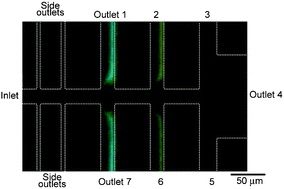Hydrodynamic filtration for on-chip particle concentration and classification utilizing microfluidics†
Abstract
We propose here a new method for continuous concentration and classification of particles in microfluidic devices, named hydrodynamic

* Corresponding authors
a Department of Chemistry and Biotechnology, School of Engineering, The University of Tokyo, 7-3-1 Hongo, Bunkyo-ku, Tokyo, Japan
b
Department of Chemical Engineering, Graduate School of Engineering, Osaka Prefecture University, 1-1 Gakuen-cho, Sakai, Osaka, Japan
E-mail:
seki@chemeng.osakafu-u.ac.jp
Fax: +81-72-254-9911
Tel: +81-72-254-9296
We propose here a new method for continuous concentration and classification of particles in microfluidic devices, named hydrodynamic

 Please wait while we load your content...
Something went wrong. Try again?
Please wait while we load your content...
Something went wrong. Try again?
M. Yamada and M. Seki, Lab Chip, 2005, 5, 1233 DOI: 10.1039/B509386D
To request permission to reproduce material from this article, please go to the Copyright Clearance Center request page.
If you are an author contributing to an RSC publication, you do not need to request permission provided correct acknowledgement is given.
If you are the author of this article, you do not need to request permission to reproduce figures and diagrams provided correct acknowledgement is given. If you want to reproduce the whole article in a third-party publication (excluding your thesis/dissertation for which permission is not required) please go to the Copyright Clearance Center request page.
Read more about how to correctly acknowledge RSC content.
 Fetching data from CrossRef.
Fetching data from CrossRef.
This may take some time to load.
Loading related content
